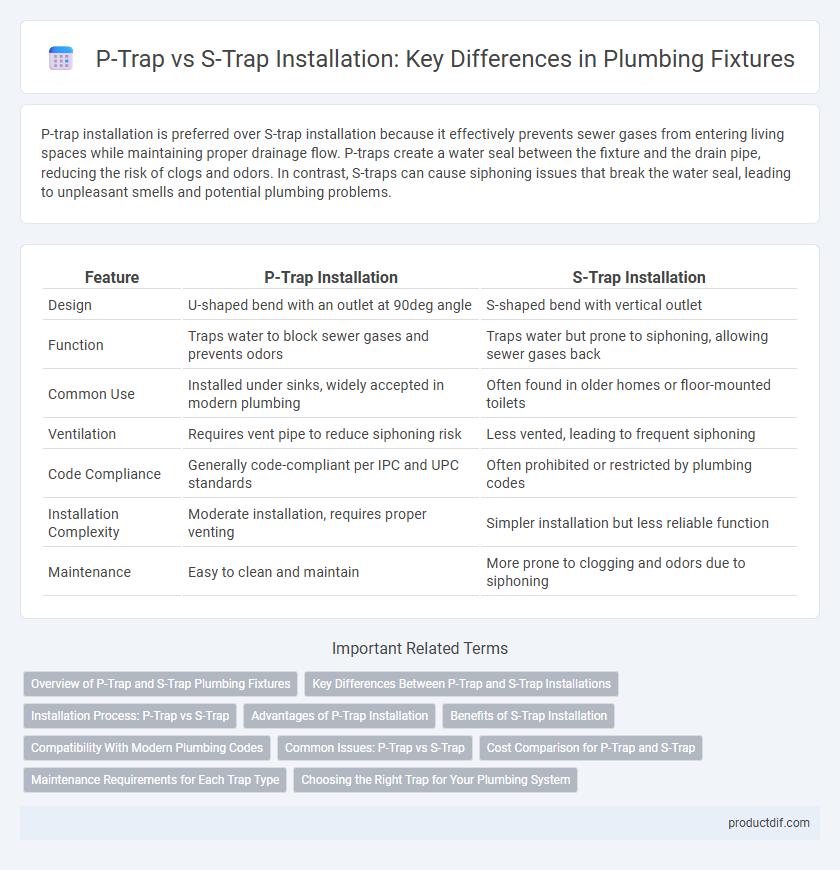P-trap installation is preferred over S-trap installation because it effectively prevents sewer gases from entering living spaces while maintaining proper drainage flow. P-traps create a water seal between the fixture and the drain pipe, reducing the risk of clogs and odors. In contrast, S-traps can cause siphoning issues that break the water seal, leading to unpleasant smells and potential plumbing problems.
Table of Comparison
| Feature | P-Trap Installation | S-Trap Installation |
|---|---|---|
| Design | U-shaped bend with an outlet at 90deg angle | S-shaped bend with vertical outlet |
| Function | Traps water to block sewer gases and prevents odors | Traps water but prone to siphoning, allowing sewer gases back |
| Common Use | Installed under sinks, widely accepted in modern plumbing | Often found in older homes or floor-mounted toilets |
| Ventilation | Requires vent pipe to reduce siphoning risk | Less vented, leading to frequent siphoning |
| Code Compliance | Generally code-compliant per IPC and UPC standards | Often prohibited or restricted by plumbing codes |
| Installation Complexity | Moderate installation, requires proper venting | Simpler installation but less reliable function |
| Maintenance | Easy to clean and maintain | More prone to clogging and odors due to siphoning |
Overview of P-Trap and S-Trap Plumbing Fixtures
P-trap and S-trap plumbing fixtures both prevent sewer gases from entering living spaces by maintaining a water seal but differ in shape and installation requirements. P-traps curve horizontally and connect to a wall drain, making them suitable for modern plumbing systems with venting, while S-traps curve vertically and connect directly to the floor drain, often lacking proper venting which can cause siphoning issues. Building codes typically favor P-traps over S-traps due to their reliable venting and reduced risk of vacuum formation.
Key Differences Between P-Trap and S-Trap Installations
P-trap installations feature a horizontally oriented trap arm connecting to the drainpipe, enabling a natural water seal that prevents sewer gases from entering the living space. S-traps, characterized by a vertical exit pipe creating a siphoning effect, often lose their water seal due to wastewater flow, increasing the risk of odor and gas leakage. Plumbing codes frequently ban S-traps because they lack venting control, while P-traps are preferred for their code compliance and reliable venting compatibility.
Installation Process: P-Trap vs S-Trap
The installation process of a P-trap involves connecting the trap directly to the tailpiece beneath the sink, ensuring a horizontal outlet that vents properly through the wall. In contrast, an S-trap installation connects the trap to a vertical drain pipe that goes directly into the floor, often resulting in improper venting and potential siphoning issues. P-traps require precise alignment and venting to maintain water seals, while S-traps are simpler but less effective in preventing sewer gas leakage.
Advantages of P-Trap Installation
P-trap installation offers superior odor prevention by maintaining a consistent water seal that effectively blocks sewer gases from entering living spaces. Its design simplifies cleaning and maintenance by providing easy access to trap debris, reducing the risk of clogs in plumbing systems. Compared to S-traps, P-traps comply with modern plumbing codes, ensuring better functionality and long-term reliability in residential and commercial applications.
Benefits of S-Trap Installation
S-trap installation offers enhanced water seal performance, effectively preventing sewer gases from entering living spaces due to its deep trap design. It requires fewer parts and simpler installation compared to P-traps, reducing labor costs and potential leak points. Ideal for floor-mounted fixtures, S-traps maximize space efficiency in compact bathroom layouts.
Compatibility With Modern Plumbing Codes
P-trap installation complies with modern plumbing codes by providing effective water sealing that prevents sewer gas from entering living spaces, meeting ventilation and backflow prevention requirements. S-traps often fail to meet current code standards due to their tendency to siphon water from the trap, causing potential gas leaks and health hazards. Modern plumbing systems favor P-traps for compatibility with venting systems, ensuring safer and more reliable drainage performance.
Common Issues: P-Trap vs S-Trap
P-traps and S-traps are essential plumbing fixtures designed to prevent sewer gases from entering living spaces, but S-traps often suffer from siphoning issues that cause water seals to break, leading to unpleasant odors. P-traps, with their horizontal outlet, maintain a consistent water seal and comply better with modern plumbing codes, reducing the likelihood of leaks and clogs. Common issues with S-trap installations include water seal loss and difficulty venting, which can be avoided by using P-traps for reliable drainage and effective venting.
Cost Comparison for P-Trap and S-Trap
P-trap installations generally cost more upfront due to their complex design and material requirements compared to S-traps. S-traps are typically cheaper and easier to install but may incur higher long-term costs from potential plumbing issues and code violations. Investing in a P-trap can reduce costly repairs and drainage problems over time despite the higher initial expense.
Maintenance Requirements for Each Trap Type
P-trap installation requires less maintenance due to its design, which effectively prevents sewer gases from entering the home and minimizes clogging by trapping debris in an accessible curve. S-trap installations often demand more frequent attention because their shape can cause siphoning, leading to water seal loss and unpleasant odors requiring regular resealing or venting adjustments. Proper maintenance of P-traps generally involves occasional cleaning, while S-traps may necessitate more frequent professional inspections to ensure proper function.
Choosing the Right Trap for Your Plumbing System
Choosing the right trap for your plumbing system depends on the specific drainage setup and local plumbing codes. P-traps are preferred for most modern installations due to their ability to maintain a water seal and prevent sewer gases from entering the home, while S-traps are typically used in floor drains but are prone to siphoning and losing the trap seal. Proper installation and venting are critical to ensure effective trap function and compliance with plumbing standards.
P-trap installation vs S-trap installation Infographic

 productdif.com
productdif.com